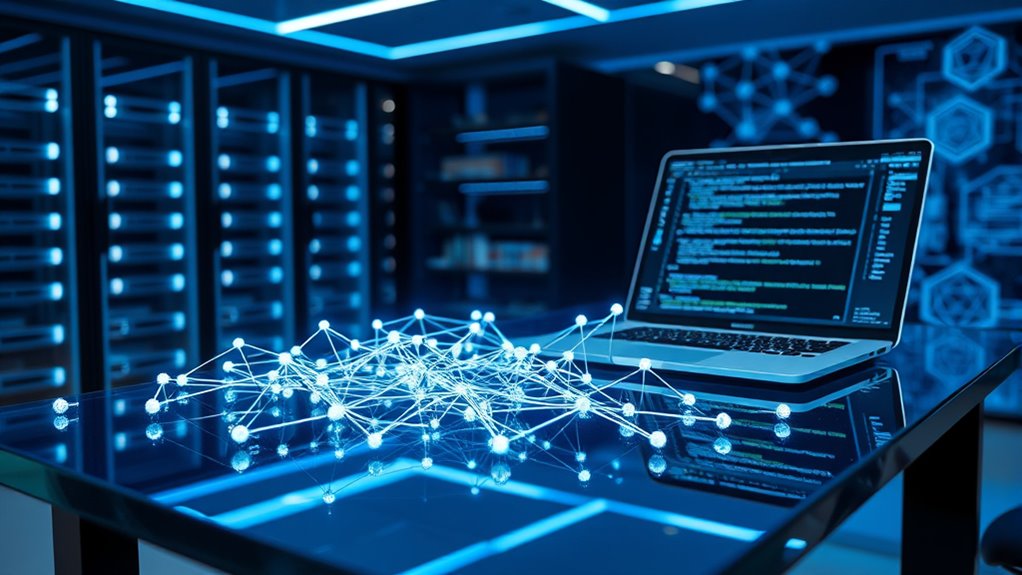Graph databases and LLMs work together to enhance how you manage complex, interconnected data. Graph databases model relationships directly, making it easier to navigate and analyze intricate data webs. LLMs understand natural language, enabling more intuitive, context-aware interactions. Combining these tools allows you to discover hidden insights and explore data more naturally. By integrating relationship modeling with semantic understanding, you’ll unleash powerful new ways to handle data—if you explore further, you’ll uncover more exciting possibilities.
Key Takeaways
- Graph databases excel at modeling complex, interconnected data, providing a foundation for semantic analysis with LLMs.
- LLMs enhance graph databases by interpreting natural language queries, enabling more intuitive data retrieval.
- Combining both allows for automatic discovery of hidden or indirect relationships within data networks.
- The integration supports richer, context-aware insights through semantic understanding of graph-structured data.
- This synergy improves data exploration, analysis speed, and adaptability for evolving, complex datasets.

Graph databases and large language models (LLMs) are transforming how we handle complex data relationships and generate insights. When you work with vast, interconnected datasets, traditional databases often fall short, leaving you with limited ways to uncover meaningful patterns. That’s where graph databases shine—they excel at modeling relationships directly, making it easier for you to navigate and analyze intricate connections. By leveraging relationship modeling, you can represent real-world entities and their interactions in a way that mirrors natural data structures. This approach allows for more intuitive queries and faster retrieval of relevant information, especially when dealing with highly connected data.
Semantic querying takes this a step further. Instead of relying solely on keyword matching or simple filters, semantic querying enables you to understand the meaning behind your data. With LLMs integrated into your graph database setup, you can interpret complex queries expressed in natural language. For example, you might ask, “Show me all the suppliers connected to products made in Europe,” and the system, powered by semantic understanding, will grasp the intent and fetch accurate results. This makes your interactions more natural and reduces the need for specialized query languages, opening up data insights to users who may not be database experts.
Relationship modeling is at the core of this synergy. It constructs a web of interconnected nodes and edges that represent entities and their relationships, providing a flexible framework for data that evolves over time. When combined with LLMs, relationship modeling becomes even more powerful. The models can analyze the relationships, infer hidden connections, and generate context-aware insights that would be difficult to uncover manually. For instance, LLMs can help identify indirect links between entities or suggest new relationships based on patterns they recognize across large datasets. Additionally, ongoing advancements in relationship modeling techniques continue to expand the capabilities of this combined approach.
Frequently Asked Questions
How Do Graph Databases Improve LLM Training Efficiency?
You improve LLM training efficiency by leveraging graph databases through faster graph traversal and data normalization. Graph traversal allows you to quickly access related data points, reducing the time spent searching for relevant information. Data normalization in graphs guarantees consistent, organized data, minimizing redundancy. Together, these features streamline data preparation, enabling your model to learn from high-quality, well-structured data more efficiently, ultimately speeding up training processes.
Can LLMS Interpret Complex Graph Structures Directly?
Think of an LLM trying to interpret complex graph structures like deciphering a city’s intricate subway map. While LLMs can recognize patterns, they struggle with deep graph interpretation due to structure complexity. They don’t directly understand the nodes and edges, making it hard to grasp nuanced relationships. So, they can analyze simplified parts but need specialized tools to truly interpret complex graphs.
What Are the Costs Associated With Integrating These Technologies?
You’ll face costs like licensing fees for the software and infrastructure expenses for hosting and maintaining these systems. Integrating graph databases with LLMs often requires substantial hardware, cloud resources, and ongoing updates, which can add up quickly. While the benefits are significant, be prepared for these costs to guarantee smooth operation, security, and scalability. Planning your budget carefully helps you balance innovation with financial sustainability.
How Secure Is Data Stored in Combined Graph Database and LLM Systems?
Imagine you accidentally leave your diary open—you’d worry about privacy. That’s why data stored in combined graph databases and LLM systems is secured with data encryption and strict access control. These measures guarantee your sensitive information remains private, only accessible to authorized users. While no system is foolproof, implementing robust security protocols greatly reduces risks, making your data safer and giving you peace of mind.
What Industries Benefit Most From Graph DBS and LLMS Integration?
You benefit most in industries like healthcare and finance when integrating graph databases with LLMs. In healthcare, this combo enhances patient data analysis, diagnostics, and personalized treatments. Financial analytics leverage these tools for fraud detection, risk management, and complex market trend analysis. The advanced relationship mapping and natural language understanding boost decision-making and efficiency, making this integration invaluable for sectors that rely on deep data insights and rapid information processing.
Conclusion
Imagine your data landscape as a vast, tangled web—graph databases unravel it with precision, while LLMs breathe life into connections with their understanding. Together, they form a symphony of insight, turning chaos into clarity. By harnessing their combined power, you’re not just steering data—you’re orchestrating a masterpiece of intelligence. Embrace this fusion, and watch your data universe transform from a tangled mess into a shining constellation of possibilities.










